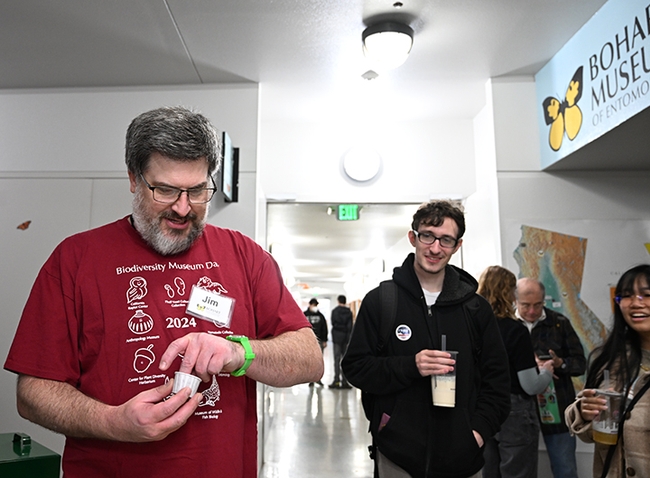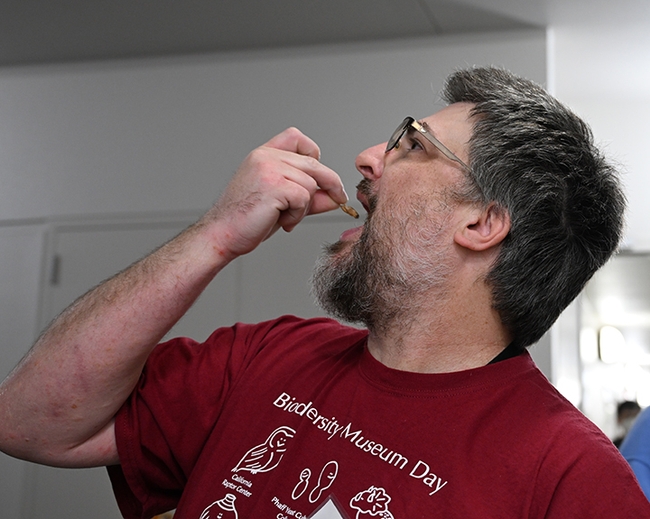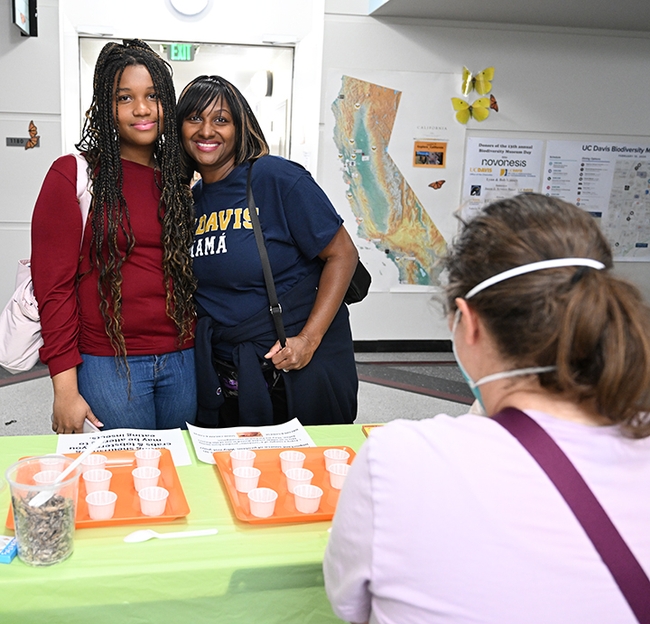
Posts Tagged: resources
Virtual fencing ‘game-changer’ for ranchers grazing cattle
Tech can save ranchers time and benefit animals and land, becoming more viable
After the Caldor Fire destroyed seven miles of fencing on their cattle ranch in 2021, Leisel Finley and her family needed to replace the fence.
Finley, a sixth-generation rancher at Mount Echo Ranch in Amador County, said reconstruction costs were bid at $300,000 and would take at least a year to build, leaving the family without summer pasture and a herd of hungry cows to feed. Additionally, the U.S. Forest Service mandates that grazing be withheld for two years in postfire landscapes. This put the family in a difficult position.
While watching a recording of a California Cattlemen's Association meeting, Finley learned about a pilot program for virtual fencing. Desperate to find an alternative solution, she registered to try the livestock containment technology, which uses GPS enabled collars to monitor each animal's location in near real time.
Livestock producers can draw a perimeter on a map of their pasture using a laptop or smartphone application and send those instructions to the collar. The collar then uses audio and tactile cues to contain the animal in the area.
Eager to discover the short- and long-term benefits of virtual fencing, Finley turned to Scott Oneto, farm advisor, and Brian Allen, assistant specialist, from the University of California Cooperative Extension office in the Central Sierra. Since partnering with Oneto and Allen, Finley said she has come to understand and uncover more of the technology's potential.
The team has consistently observed the technology's value in integrating with and enhancing traditional livestock production systems across California. Though still in its early stages of development, the location tracking and containment system appears to provide time- and cost-savings that make it a game-changer for ranchers.
Ability to monitor location of animals in real time
Virtual fencing really stands out in its ability to monitor each animal's location in real time. During roundups, ranchers can use their smartphones to see their own location relative to their herd. The system can also send alerts if an animal crosses the virtual boundary or if a collar remains stationary for an extended period, potentially indicating that the animal is sick or that the collar has fallen off.
Rounding up cattle on large, forested grazing allotments can be challenging, as the process generally requires a group of people and many return trips to find every animal. Prior to virtual fencing, Finley and her father could gather about 85% to 90% of the herd in a week. Since using virtual fencing, Finley said one of their most recent roundups lasted three days, and they located every single cow.
Something that every livestock producer dreads is the notorious call from a neighbor or California Highway Patrol alerting them that one of their cows is out in the middle of the road. It always seems to happen at midnight or while they are out with friends or family. This scenario changes with virtual fencing.
Containment based on animal behavior
The containment system that virtual fencing is built on is based on animal behavior. When the animal crosses an invisible boundary, the collar emits an audio warning, prompting most animals to instinctively turn back into the desired area. If the animal doesn't respond, the collar delivers a mild electric pulse as a secondary deterrent.
Field trials by Oneto and Allen demonstrated the system's success. Recently, the team trained a herd of 37 cattle of mixed ages that had no previous exposure to virtual fencing. During the initial six-day training period, the cattle responded to the audio warning alone about 75% of the time when they approached a virtual fence boundary, with the remaining 25% of cases requiring an electric pulse.
After about three weeks, the herd was responding to audio cues alone about 95% of the time. The field trials also showed that the collars contain the livestock within the desired areas 90% to 99% of the time when the entire herd wears virtual fence collars and their basic needs for safety, connection to the rest of the herd, water, forage, shade, etc. are met.
Opportunities for improvement
While the technology is effective in its current capacity, there are notable areas where it can improve. One limitation to the system is the current reliance on cellular networks to operate. If an animal wanders into an area outside of coverage, the collar will continue to operate based on the last instructions but won't receive updates or report locations. This is especially a concern in many areas of California with poor cell reception, including the steep forested rangelands where many livestock producers have summer grazing allotments.
Another limitation is that some companies require a solar-powered base station with radio and cellular antennas to be placed on the pasture. These facilitate the transfer of animal locations and updates to the virtual fences. A base station going offline would create the same conditions as a drop in cell signal until the base station is repaired. Some companies are currently developing collars that bypass the need for these base stations.
The other major concern for ranchers is the cost for a virtual fencing system. The average rancher can expect to pay an estimated $20,000 to $30,000 in upfront costs. The cost to set up a base station alone is $5,000 to $10,000. However, this cost is highly dependent on several factors, including the manufacturer, the number of livestock to be collared, if the livestock are large or small ruminants, and the number of GPS base stations to cover the range.
According to Allen and Finley, the high cost of virtual fencing can be offset by the unique animal and land management benefits it can provide. “While physical perimeter fencing remains essential, VF is rapidly emerging as an innovative tool to control livestock with ease, precision, and flexibility in ways that were not previously feasible with traditional fencing,” Allen said.
Finley described the technology as a “game-changer” for her family.
Virtual fencing helps control invasive grasses, installing fuel breaks
While virtual fencing is designed to contain livestock without physical fencing, it is not intended to outright replace secure perimeter fencing. Instead, it operates best as a highly dynamic and adaptable cross-fence, allowing for more intentional grazing on the landscape to meet livestock production and natural resource conservation objectives within a secure physical perimeter.
With grant funding from the USDA Natural Resources Conservation Service, the UCCE team continues to work with Finley and other livestock producers to test these applications on California's diverse rangelands.
Within the Sierra Nevada and Coast Ranges foothills, these trials include using virtual fencing on cattle for targeted grazing of invasive grasses to support the recovery of native forage and installing fuel breaks within the wildland-urban interface to remove vegetation where the edge of a pasture meets urban housing.
Using virtual fencing, 25 cattle were successfully concentrated on a field of Medusahead (Elymus caput-medusae), an invasive annual grass. The herd respected the virtual fencing boundary 99% of the time despite nearby preferable forage. Grazing reduced medusahead seed heads from 2,072 per square meter in the ungrazed control area to just 68 per square meter in the grazed section.
In a different trial, 37 cattle with virtual fencing collars were contained within 120-feet-wide fuel breaks along the boundary of an annual rangeland and residential area. Cattle stayed within the boundaries 99% of the time, leading to an 81% reduction in fine fuel biomass and lowering wildfire risk in the wildland-urban interface.
Within rangelands on conifer forests, these UCCE trials concentrate cattle on brush to reduce the flammable plants and vegetation that competes with desirable timber species. It also can prevent livestock from entering sites that are sensitive to livestock presence.
Upcoming grazing trials will focus on how virtual fencing works with goats and sheep. In addition to Oneto and Allen, UCCE's contribution to virtual fencing research is in large part due to Leslie Roche, UCCE specialist and associate professor at UC Davis, Dan Macon and Jeff Stackhouse, UCCE livestock and natural resources advisors, Kristina Horback, associate professor at UC Davis and Lone Star Ranch in Humboldt County.
To learn more about the trials led by the UCCE team,visit https://cecentralsierra.ucanr.edu/Virtual_Fencing/
CAMBP Classes on Pollinator Gardens and Apiary Technology
Like to learn about planning a year-round native pollinator garden or about technology in the...

Honey bee nectaring on tower of jewels, Echium wilpretii. This is a non-native, but isn't it pretty? The California Master Beekeeper Program is offering a class on "Planning Year-Round Native Plant Pollinator Garden" on Nov. 17. (Photo by Kathy Keatley Garvey)

A class on "Technology in the Apiary" will be offered Dec. 7 by the California Master Beekeeper Program. (Photo courtesy of the California Master Beekeeper Program)
Mosquitoes, Malaria and the Civil War
Not many Americans think about mosquitoes and malaria on Nov. 11, Veterans' Day. But they...
Why Phoenix Is the Place to Be Nov. 10-13
Phoenix is the place to be Nov. 10-13. That's the site of the Entomological Society of America's...

The UC Davis Entomology Graduate Student Association (EGSA) will be selling its member-designed t-shirts at the ESA meeting in Phoenix. Iris Quayle (left) of the Jason Bond lab, and Mia Lippey of the Meineke lab, will be giving presentations and also staffing the EGSA table. (Photo by Kathy Keatley Garvey)

Doctoral student Grace Horne, who studies with urban landscape entomologist Emily Meineke, will present the Environmental Entomology’s People’s Choice Runner-up presentation at the ESA meeting. It's titled "Specialist Herbivore Performance on Introduced Plants during Native Host Decline."
Pass the Crickets, Please!
"Crickets, anyone? Free sample!" Tabatha Yang, education and outreach coordinator for...

Postdoctoral research scientist James Starrett, of the arachnology lab of Professor Jason Bond, director of the Bohart Museum, gets ready to eat a crickette. (Photo by Kathy Keatley Garvey)

Down the hatch! UC Davis research scientist and arachnoogist James Starrett enjoying a crickette. (Photo by Kathy Keatley Garvey)

UC Davis student Nia Rhodes, an atmospheric science major, stopped by the cricket booth with her mother, Elizabeth Rhodes of Los Angeles, who is wearing a "UC Davis Mama" shirt. It was Davis Parent and Family Weekend. In the foreground is Tabatha Yang, the Bohart Museum's education and outreach coordinator. (Photo by Kathy Keatley Garvey)




